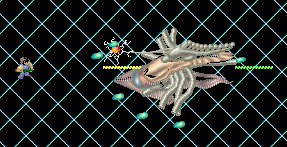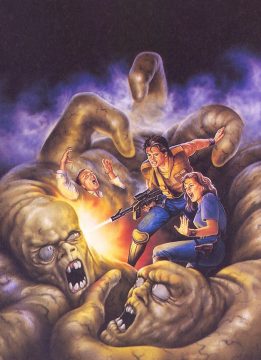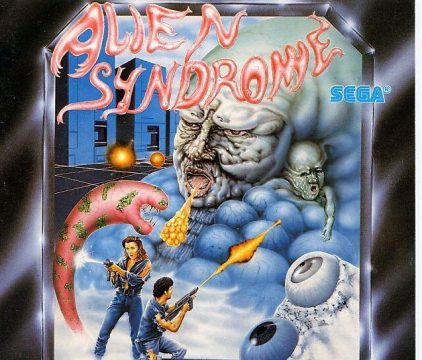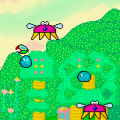- Alien Syndrome
- Alien Syndrome (2009)
Alien Syndrome is pretty clearly a rip off of the movie Aliens, since Konami had the actual license to the movie (and made their own suitable arcade entry). Although it looks like a typical overhead, character-based shooter, Alien Syndrome is a rather far stretch from linear games like Commando. Players can take control of either Ricky or Mary (outer space commandos who are absolutely in no way related to Michael Biehn or Sigourney Weaver), or both during simultaneous two-player action. Each of the stages takes place on one of seven invaded colonies, where the aliens have trapped the humans in cocoons and biologically contaminated most of the structures.
As an insurance plan in case Ricky and Mary can’t save the day, each of the colonies is set to explode after a certain amount of time. You’re therefore working against the clock to find enough hostages, get to the exit, and kill the boss. The stages aren’t particularly complex, but there are maps posted around that will clue you in on the locations of your comrades. In addition to your clumsy little pea shooter, you can also find new weapons like lasers and two different kinds of flamethrower, in addition to options that shoot behind your character. With the constantly spawning enemies, Alien Syndrome manages to emulate the feel of Gauntlet without all of the clumsiness.
Alien Syndrome has no tolerance for screw-ups. You cannot continue, at all. While the levels don’t pose too much of a challenge, some of the boss encounters can be quite difficult, especially if you get killed and revert to the default cannon. You’re even forced to use it during the final confrontation, regardless of how well you’ve done. The high difficulty level adds to an atmosphere of complete terror. The music is tense, low-key, and incredibly creepy. A single tap from an enemy and your player will cry out a blood-curdling scream before collapsing. It’s all rather unnerving.
But what really makes the game memorable are the awesomely grotesque boss designs. The first boss is a gigantic rotund ball with a little green dude sticking out from whatever would be classed as its shoulder. After taking enough hits the body explodes, leaving behind a head which morphs into some kind of twisted thing with an extended jaw and ugly horns when it attacks. The second boss appears to be a pulsating heart surrounded by blobs. The third boss is a strange, lumbering, multi-legged creature with eyes that detach and float around the screen, which looks both goofy and horrific. The sixth boss is an alien grasshopper with what appears to be a baby’s head. The final boss, which hijacks itself onto your ship a la the finale of the original Alien, looks like half of a human face stripped of its skin, leaving another head dangling from its nose, and huge distended ears that fire bullets. The “body horror“ aspect is still the best part of this classic.
The Famicom / NES version – published by Sunsoft in Japan and Tengen in America – is relatively faithful to the arcade version, even offering two-player simultaneous play and a new intro cinema. The characters walk much slower, though, and you must rescue every single prisoner before you can fight the boss. The bosses are also pretty similar, although some of their attacks had to be scaled down.
The Sega Master System version is practically a whole new game. The scrolling is gone, and instead it flips screen-by-screen like the original The Legend of Zelda. All of the levels are completely different (although the first stage is patterned after the second level of the arcade game), and each feels more maze-like. Some of the enemies are the same, but the vast majority are unique to this version. On that note, while a few of the bosses have been carried over (although slightly altered), most of them are entirely new, and manage to be just as awesome as the arcade bosses, despite the lower color palette. The weapons have been cut down, so there’s only flamethrower and laser power-ups. Sadly, there’s no map at all.
However, the game is even more difficult than the arcade version, impossibly so. Each room starts out empty and foes slowly blink onto the screen. It’s way too easy to accidentally have an enemy appear beneath you for a cheap kill. Most of the weapons have a slow firing rate, so if you fire before an enemy has completely appeared it’ll pass harmlessly through them. This leaves you defenseless for a second, which can be the difference between life and death.
The boss fights are even more unforgiving, since they have a tendency to back you into a corner and use a simple three-way bullet pattern that’s nearly impossible to dodge, given the close quarters. Furthermore, the hit detection is quite sloppy and striking the enemy’s weak point seems like a matter of chance. Again, there are no continues, and the standard weapon is useless, so if you get killed you may as well give up. The only real high point is the tremendously scary death screams, which are even louder and more disturbing than the arcade version.
The Game Gear release is, oddly enough, the best of the 8-bit home ports. According to the intro, this version is actually a sequel set five years after the original Alien Syndrome. The gameplay is much like the arcade version, with many of the same bosses, although there are four (mostly) new levels. You can now access the map screen at any time, and can power up weapons by grabbing the same kind twice. It still suffers from a bit of slowdown and flicker, but it’s surprisingly cool, and has some awesome cover artwork.
As far as computer ports go, all of are based on the arcade version. The Commodore 64 release is pretty decent, barring some slow screen-scrolling. The Amiga, Atari ST and PC versions are almost graphically identical, and feature some redesigned, brighter visuals. All of these versions suffer from some jerky scrolling; the Amiga has the upper hand for sound but is missing a few levels. In spite of this, they all play fairly well. The X68000 version, ported by Dempa, is practically arcade-perfect. The only other nearly-perfect port is found on Sonic’s Ultimate Genesis Collection for PS3 and Xbox 360.
After disappearing for approximately 15 years, Sega resurrected Alien Syndrome for their Sega Ages 2500 series, which appeared in the US in the Sega Classics Collection, but was absent from the European release. The 3D graphics aren’t pretty, and they’re way too dark, but they do a decent job of emulating the feel of the Alien movies. The biggest change is the addition of dual analog movement, so you can move with one stick and fire with the other as in Robotron 2084 and Smash TV.
There are a few new weapons, including some useless grenades and a spread shot. The pacing is a bit slower, but feels more chaotic, with more being thrown at you at once. However, you also now have a life bar, along with unlimited continues, so it’s not nearly as tense as the original arcade game, losing some of its appeal. Sega also increased the gore quotient by making bad guys explode in a mess of blood.
The 3DS version is only found on Sega 3D Fukkoku Archives 3. Other than 3D effects, there are no major changes from the arcade version.






